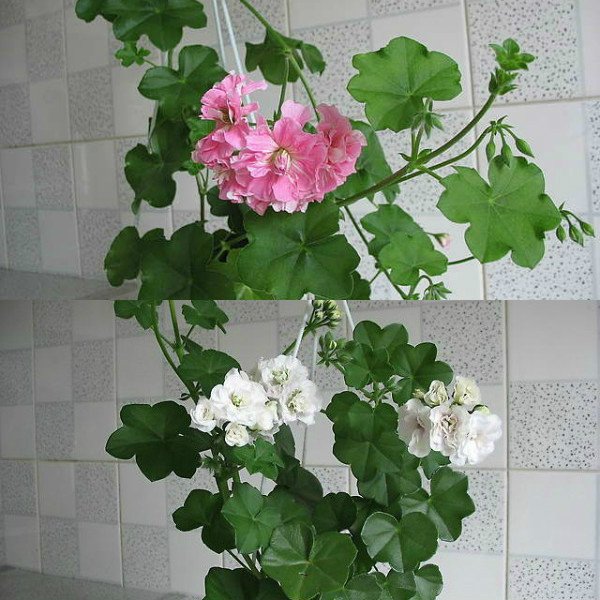
Ivy geranium. Geranium ivy: care for her, methods of reproduction
Ampelous pelargonium is one of the most favorite plants of flower growers; as a rule, it adorns parks, balconies, terraces, open areas and spacious rooms. She is valued for her beautiful flowers and leaves, and she blooms brightly and for a long time. Ivy pelargonium is loved by both experienced flower growers and pensioners who are poorly versed in the intricacies of caring for this fragrant plant. The plant is originally from Africa, and in Europe it appeared only a few centuries ago. Care at home is not difficult, reproduction is carried out by cuttings in the process of annual pruning. Cuttings quickly give the root system and do not require special skills for rooting. Look at the photo of ampelous pelargonium and overshadow all the advantages of this plant for indoor floriculture: 
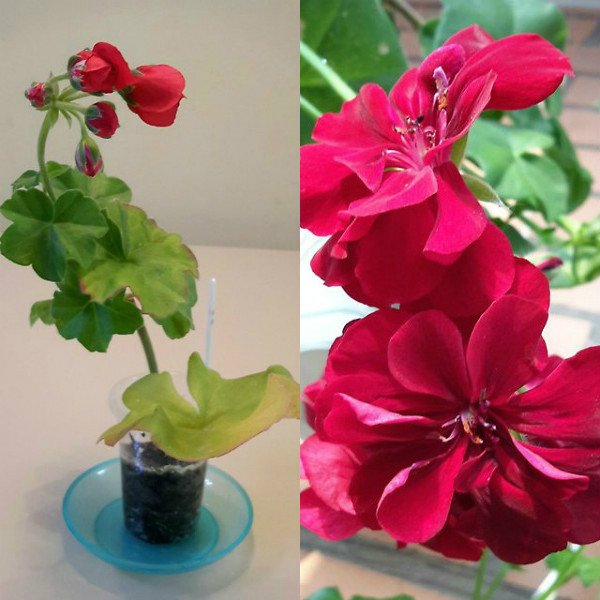
What is ampelous ivy pelargonium?
Pelargonium is often called geranium, and both of these names are associated with birds. If the first word is translated from Greek as a stork, then the second from the same language is like a crane. The beaks of these birds resemble the fruits of this plant. As a rule, pelargonium is called a perennial growing at home. And geranium is a frost-resistant plant that winters quietly in the garden or in the flower bed. What is ivy ampelous pelargonium from the point of view of a home phytodecorator? This is a plant with which you can create unique green interiors that do not require special experience in breeding flowers.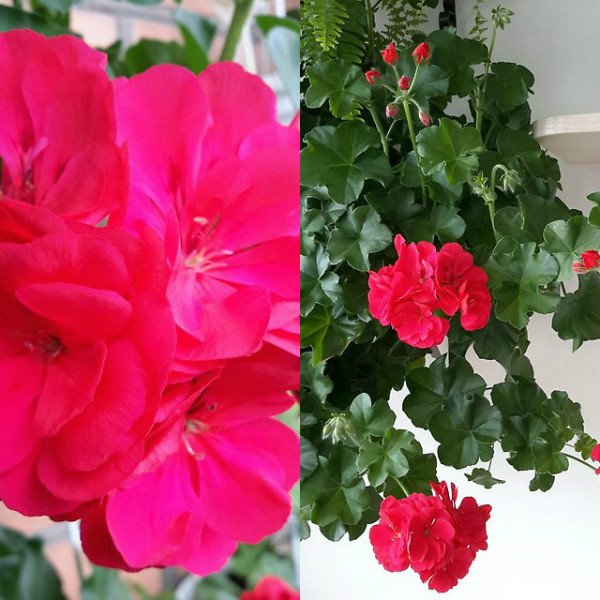
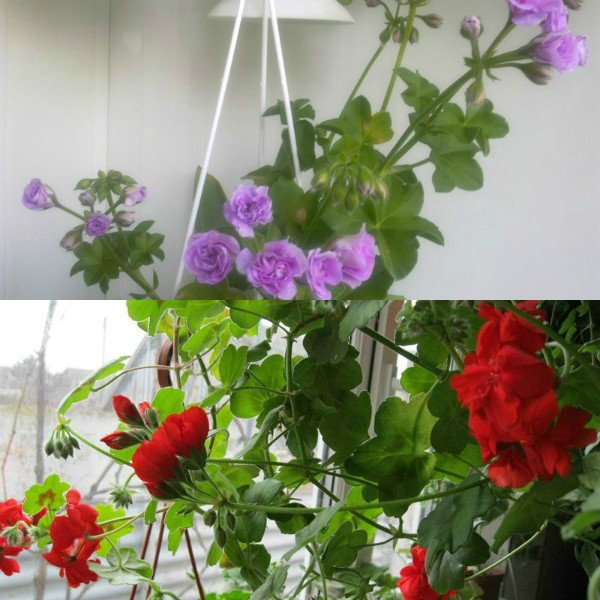
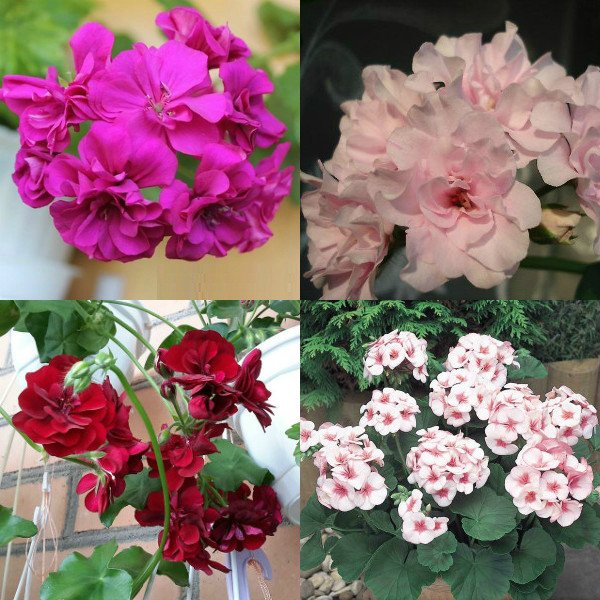 The word ampelous in the name of the plant comes from the German ampel (flower vase), which, in turn, goes back to the Latin ampulla, which means "small flask". In ornamental ampelous plants, the shoots are flexible. They are good for the so-called hanging gardens. These include the ampelous ivy-leaved pelargonium, the length of the shoots of which reaches almost one meter. It comes from southern Africa, where it falls from the slopes of the hills. It differs from a vertically growing pelargonium in that its leaves are smooth, without fluff, five-lobed, three to six centimeters wide. Star-shaped and cactus-shaped flowers are collected in an inflorescence in the form of an umbrella. It has up to thirty flowers that bloom for five to six days. The flowers of the plant come in a variety of colors and shades.
The word ampelous in the name of the plant comes from the German ampel (flower vase), which, in turn, goes back to the Latin ampulla, which means "small flask". In ornamental ampelous plants, the shoots are flexible. They are good for the so-called hanging gardens. These include the ampelous ivy-leaved pelargonium, the length of the shoots of which reaches almost one meter. It comes from southern Africa, where it falls from the slopes of the hills. It differs from a vertically growing pelargonium in that its leaves are smooth, without fluff, five-lobed, three to six centimeters wide. Star-shaped and cactus-shaped flowers are collected in an inflorescence in the form of an umbrella. It has up to thirty flowers that bloom for five to six days. The flowers of the plant come in a variety of colors and shades. 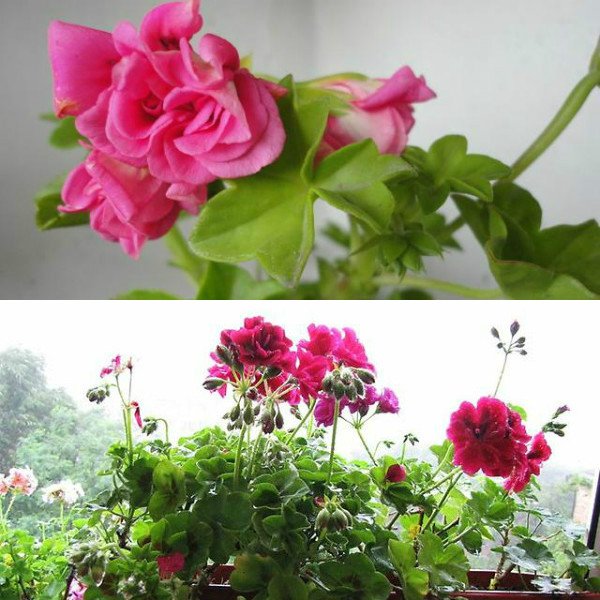

Planting ampelous pelargonium and subsequent care for it
For planting an ampelous pelargonium flower, hanging baskets, planters, flowerpots, window and balcony boxes are used. Most often, these light-loving plants adorn the sunny facades of houses, where they look both organically and beautifully. Pelargonium ivy, or ampelous, differ from other species in that they have hanging or creeping shoots from twenty centimeters to one meter long. It is this type that is widely used for decorating windows, loggias or balconies. Landing can be done in spring or early autumn. Subsequent care for it consists in timely watering and the application of mineral fertilizers. It is easy to care for pelargonium at home, it grows normally under certain conditions. It is necessary to monitor fluctuations in temperature, illumination, the amount of moisture in the soil. The temperature in the room where pelargonium grows in the warm season should be on average 22-23 degrees, and in the cold season it should not be lower than 12-15 degrees. For planting, it is necessary to prepare soil acceptable for it: an approximately equal amount of sand, humus soil is taken, there should be a large amount of potassium in the ground, but there should not be much nitrogen. The fact is that with an excess of nitrogen, the rate of flowering slows down, and the leaves, on the contrary, become larger. Seedlings are planted in a window box in one row, at a distance of about fifteen centimeters from each other. At the end of spring frosts, they can already be put outside, and in April-May and summer, pelargonium should be watered regularly, fertilizing with small doses of mineral fertilizers.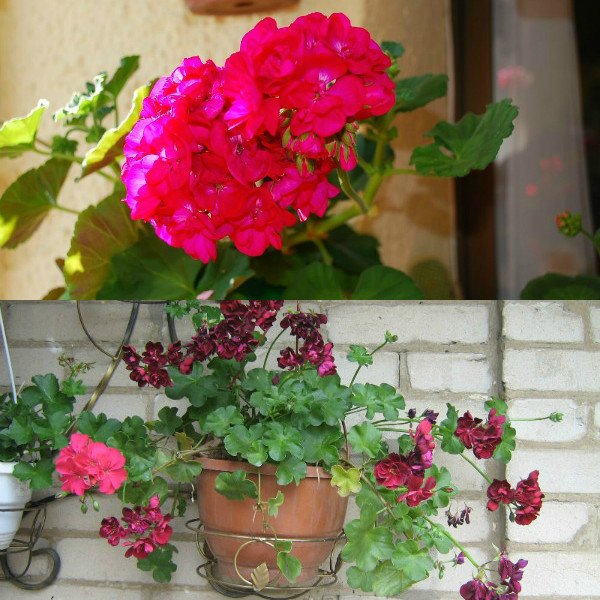
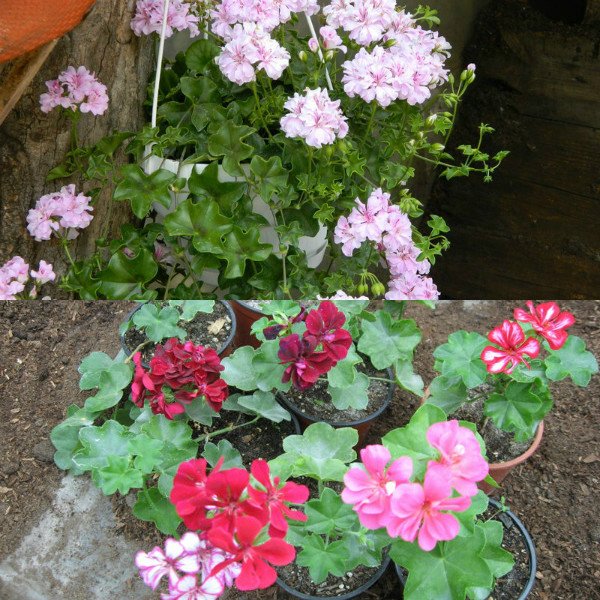 Watering a plant also requires certain conditions: the soil in a pot or box should be moderately moist. If it is more than normal, it will stagnate in the container and mold may eventually appear. Excess moisture can be removed by draining through small holes in the bottom of the container. In summer, water more often, in winter - less often, once every one and a half to two weeks. At the same time, ampelous geraniums do not need to be sprayed, since moisture on the leaves can give rise to foci of decay on them. For good growth, the plant needs fresh air, so airing the room is necessary, but drafts should be avoided. In winter, it is desirable to place pelargonium in such a way that it has additional lighting, while the ground part can not be cut off. But in the spring, pruning will give the pelargonium a downright chic splendor.
Watering a plant also requires certain conditions: the soil in a pot or box should be moderately moist. If it is more than normal, it will stagnate in the container and mold may eventually appear. Excess moisture can be removed by draining through small holes in the bottom of the container. In summer, water more often, in winter - less often, once every one and a half to two weeks. At the same time, ampelous geraniums do not need to be sprayed, since moisture on the leaves can give rise to foci of decay on them. For good growth, the plant needs fresh air, so airing the room is necessary, but drafts should be avoided. In winter, it is desirable to place pelargonium in such a way that it has additional lighting, while the ground part can not be cut off. But in the spring, pruning will give the pelargonium a downright chic splendor. 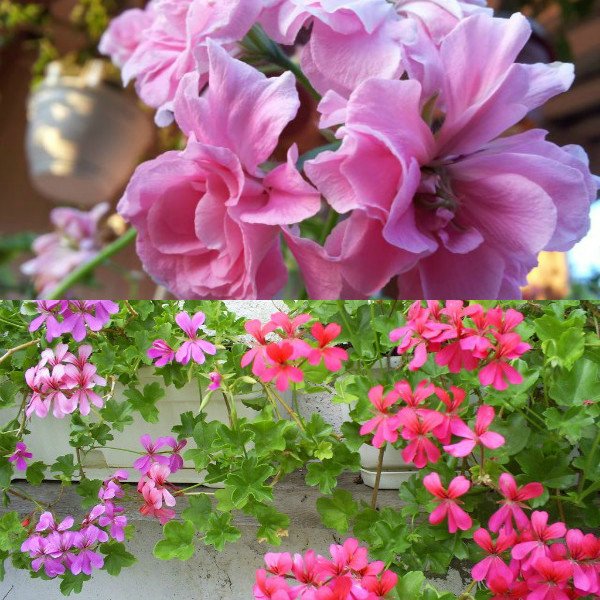
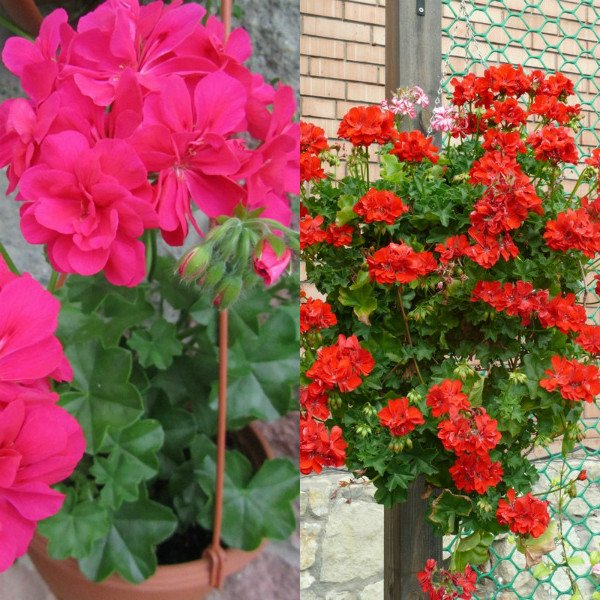 At room temperature, plant pots should be kept as far away from heating appliances as possible. In winter, pelargonium should not be watered too often - once every one and a half to two weeks is enough. By the way, it is more difficult to “please” pelargonium in winter, because it needs more light. It is important to feed the pelargonium in time. When caring for ampelous pelargonium, it should be remembered that from March to August, during the flowering period, it is necessary to feed the plant weekly. Mineral fertilizers, as already mentioned, should be used in small concentrations. Flower growers have long noticed that milk diluted with water is very useful for pelargonium. But some believe that geraniums do not need to be fertilized. It grows well in fresh fertilized soil, so in the spring it is better to transplant it into a new pot with fresh soil, moderately fertilized. Such land can be purchased at specialized stores, or you can prepare the soil yourself. Recommendations on how and in what proportions to do this can be obtained from any specialist or experienced amateur.
At room temperature, plant pots should be kept as far away from heating appliances as possible. In winter, pelargonium should not be watered too often - once every one and a half to two weeks is enough. By the way, it is more difficult to “please” pelargonium in winter, because it needs more light. It is important to feed the pelargonium in time. When caring for ampelous pelargonium, it should be remembered that from March to August, during the flowering period, it is necessary to feed the plant weekly. Mineral fertilizers, as already mentioned, should be used in small concentrations. Flower growers have long noticed that milk diluted with water is very useful for pelargonium. But some believe that geraniums do not need to be fertilized. It grows well in fresh fertilized soil, so in the spring it is better to transplant it into a new pot with fresh soil, moderately fertilized. Such land can be purchased at specialized stores, or you can prepare the soil yourself. Recommendations on how and in what proportions to do this can be obtained from any specialist or experienced amateur. 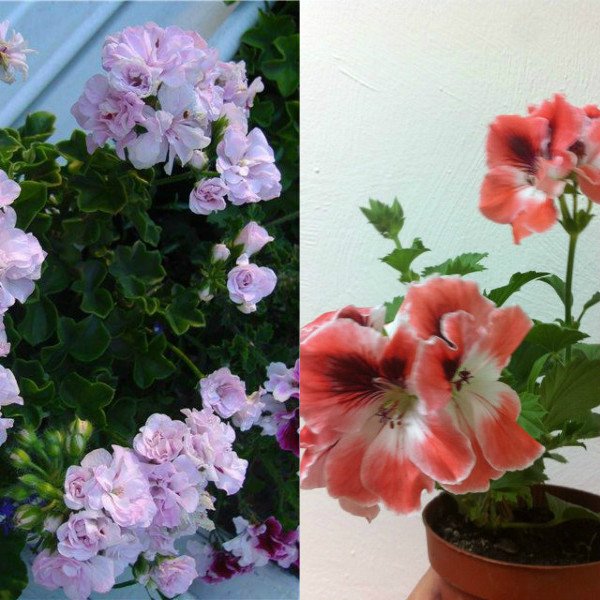
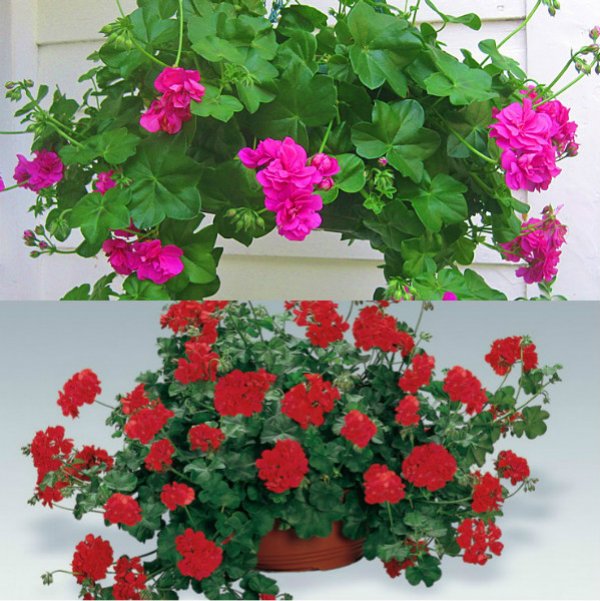
Reproduction of ampelous pelargonium
Flower growers sometimes practice growing ampelous pelargonium from seeds, but rightly consider this to be too troublesome, since many nuances must be taken into account. Therefore, it is preferable to propagate ampelous pelargonium with cuttings, previously dried for about a day. For reproduction, dry sections, having previously been dipped in coal powder, which acts as a growth stimulator, are planted in disinfected soil. Disinfection can be carried out with boiling water or held in a hot oven for about ten minutes, and then cooled to room temperature. The distance between the cuttings is not more than two centimeters. The soil around them must be compacted. If all this is done in the spring, then in the summer the pelargonium will definitely bloom. But if there are no cuttings, then it can be grown from seeds, especially since they are sold completely freely. The most favorable time for sowing is the beginning of winter. Florists recommend sowing them to a depth of about five millimeters. The optimum soil temperature for propagation of ampelous pelargonium by seeds is up to 25 degrees. After a few days, the seeds can sprout, but, as the experience of professional flower growers and amateurs shows, it is rarely possible to get a full-fledged flower from seeds. If a plant has a bare stem during the winter months, there is no need to rush to rejuvenate it by cutting it into cuttings. In this case, you just need to pinch the top. After that, new shoots appear from the buds, and the plant blooms faster and more magnificently.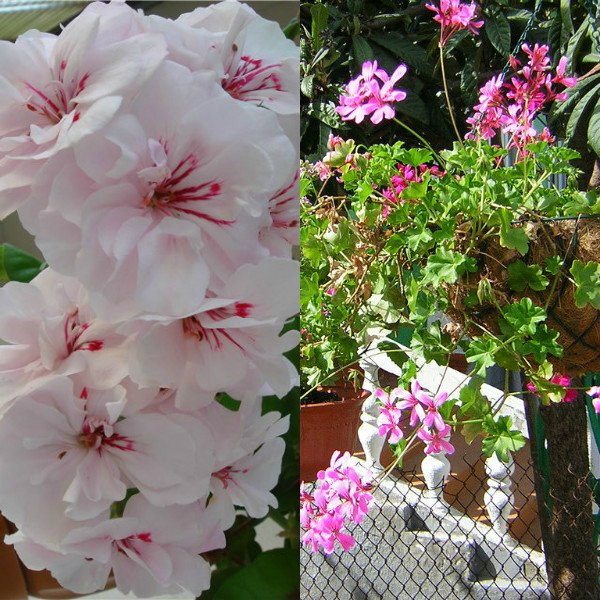
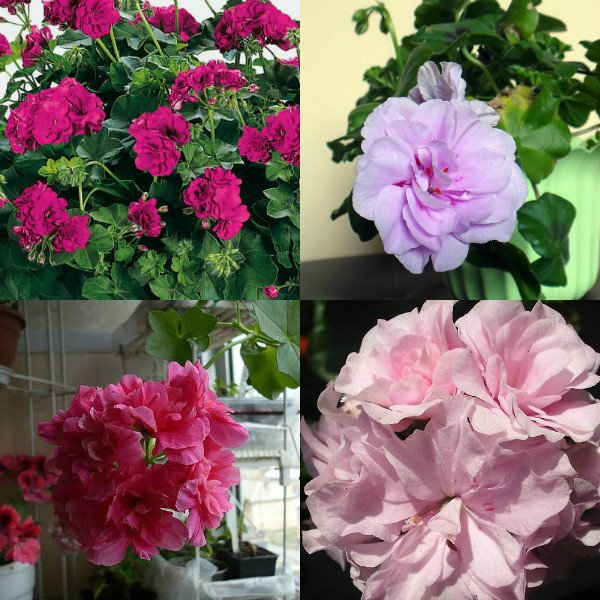
Varieties of ampelous pelargonium (with photo)
Today, in stores and markets, you can buy geraniums of various varieties, including ampelous pelargonium. Decorative leaves and flowers of bright and unusual shades on the window or balcony will delight not only the owners of the apartment, but also the neighbors. And passers-by are unlikely to remain indifferent. For three or four centuries of breeding, a wide variety of hybrids and varieties of ampelous pelargonium have appeared: variegated, dwarf, white and two-color, with double flowers and others. They are grown not only because of the bright, unusual colors of flowers, but also because of the leaves that have a unique aroma. Look at the photo for some varieties for indoor floriculture: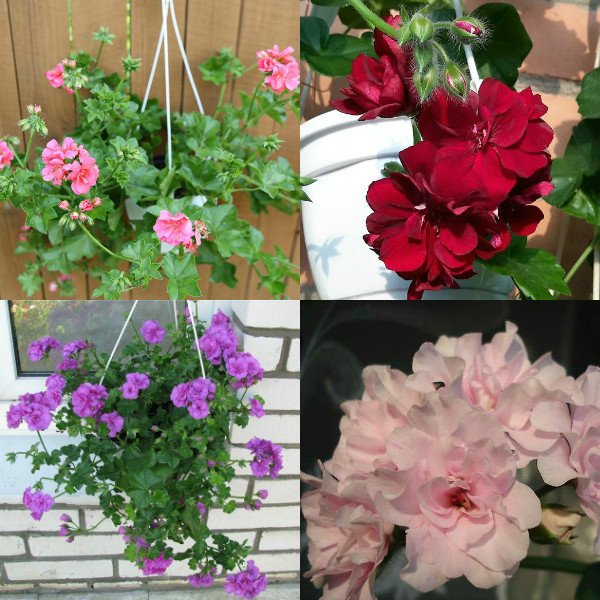
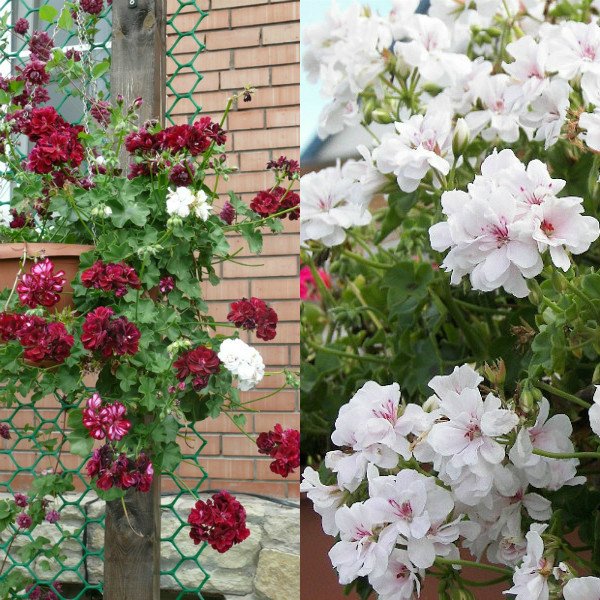
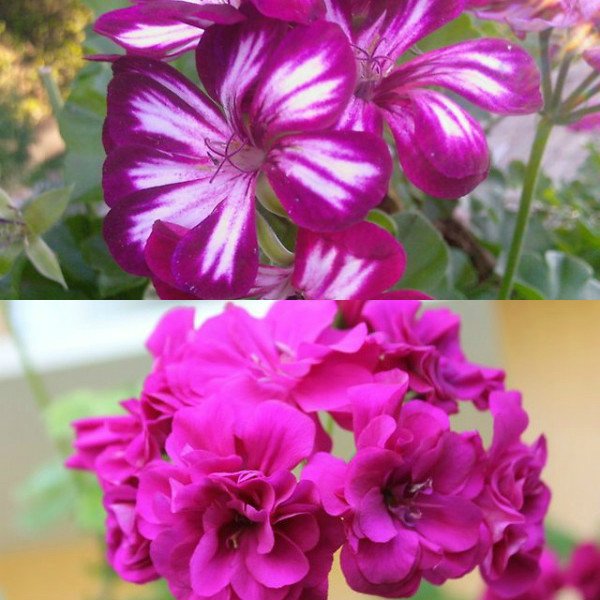 There are many species and varieties, the most common of which are zonal pelargoniums, the varieties of which number several tens of thousands. This species got its name because of the so-called zones on leaves that have a different color. At the same time, in winter, when there is little light, they disappear, and in the spring they appear again. There are rosaceous pelargoniums with buds similar to pink and tulip-shaped, whose flowers resemble tulip buds - they were bred by American amateur breeders in the middle of the last century. Star pelargonium is a rare species. It is characterized by twisted flower petals. Carnation varieties look like garden carnations. It has large sizes and flowers with a ruffled edge. The peculiarity of its color is that it does not have monochromatic shades of white, burgundy, purple and pink. Variety "Angel" resembles outwardly astermeria. It was obtained by selection in the 30s of the last century. This variety also belongs to the group of royal. Photos of ampelous pelargonium of this variety can be found on Internet resources. Fragrant geranium exudes a strong aroma and usually has many small flowers in the inflorescence. When grown at home, it forms a small bush, the height of which can reach one meter. Adhering to simple recommendations, you can easily grow a luxurious flower that will decorate your interior. In addition, according to popular beliefs, pelargonium has magical properties, can resist negative evil spirits and maintains well-being in the family.
There are many species and varieties, the most common of which are zonal pelargoniums, the varieties of which number several tens of thousands. This species got its name because of the so-called zones on leaves that have a different color. At the same time, in winter, when there is little light, they disappear, and in the spring they appear again. There are rosaceous pelargoniums with buds similar to pink and tulip-shaped, whose flowers resemble tulip buds - they were bred by American amateur breeders in the middle of the last century. Star pelargonium is a rare species. It is characterized by twisted flower petals. Carnation varieties look like garden carnations. It has large sizes and flowers with a ruffled edge. The peculiarity of its color is that it does not have monochromatic shades of white, burgundy, purple and pink. Variety "Angel" resembles outwardly astermeria. It was obtained by selection in the 30s of the last century. This variety also belongs to the group of royal. Photos of ampelous pelargonium of this variety can be found on Internet resources. Fragrant geranium exudes a strong aroma and usually has many small flowers in the inflorescence. When grown at home, it forms a small bush, the height of which can reach one meter. Adhering to simple recommendations, you can easily grow a luxurious flower that will decorate your interior. In addition, according to popular beliefs, pelargonium has magical properties, can resist negative evil spirits and maintains well-being in the family. 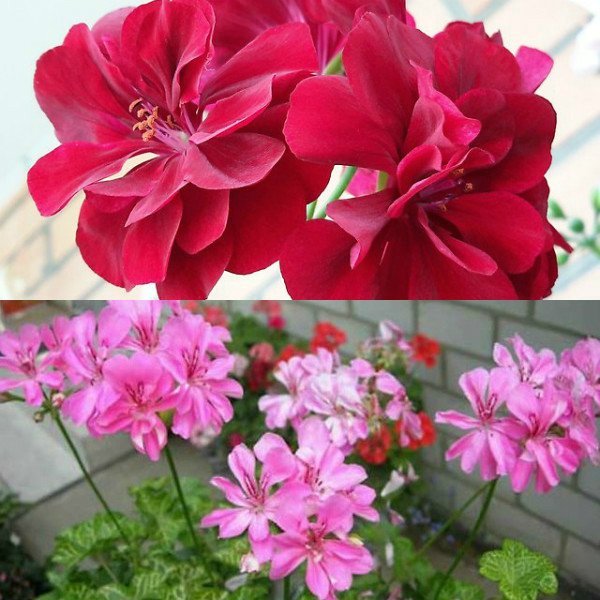
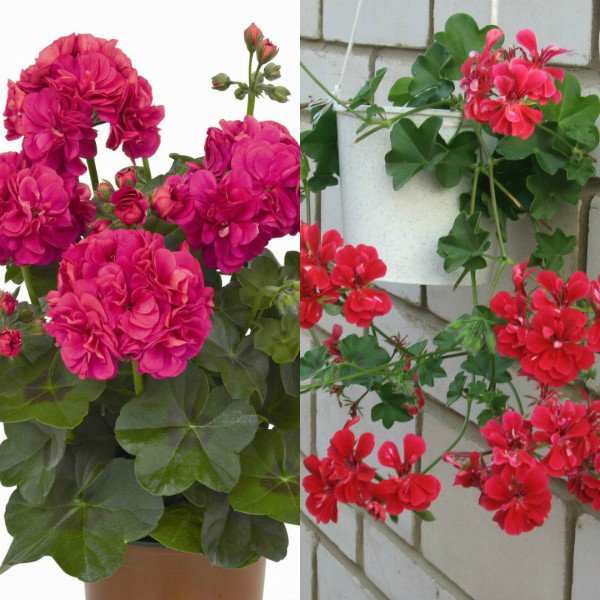 prominent
prominent Pelargonium in a window box
author Kruglikova S., photo of the authorPelargoniums are the favorite plants of flower growers of the world. In many countries withoutvarious pelargoniums both large parks and tiny patios are inconceivable. Pelargoniums traditionallydecorate balconies , windows of houses, terraces, flower beds of different styles.
We appreciate pelargoniums for bright and abundant flowering, for decorative leaves, for their lush appearance. flowering plants throughout the season, for their unpretentiousness.
In flower beds, in flower beds and in pots, it is most often grown pelargonium zonal(Pelargonium zonale) is an erect semi-shrub with almost round leaves (green, variegated, golden, with a contrasting ring around the center of the leaf). Corymbose inflorescences with caps of flowers of various colors rise above the leaves of zonal pelargoniums.
For cultivation as a carpet plant, as well as for vertical gardening, it is used pelargonium thyroid, or pelargonium ivy(Pelargonium peltatum). Thyroid pelargonium is decorated with retaining walls and raised flower beds, this plant is planted in hanging baskets and wall planters, indecorative flowerpots on a high pedestal, in window and balcony boxes.
My article is devoted to the cultivation and maintenance of this wonderful ampel - ivy-leaved pelargonium.
Growing Ivy Pelargonium
Pelargonium thyroid is a creeping shrub with thin but strong shoots 70-100 cm long. This species has five-lobed, rather dense fleshy leaves, green or white-motley (with white veins or with a white border).
Long peduncles, formed in the axil of each leaf of the ivy pelargonium, bear loose inflorescences of graceful star-shaped flowers.
Many varieties of thyroid pelargonium have been bred with all kinds of colors of delicate flowers - white, salmon, pink, red, raspberry, purple, as well as bicolor and with contrasting veins on the petals. Flowers are simple or double; usually they are 1.5-2.5 cm in diameter, in some large-flowered varieties up to 4 cm.
Thyroid pelargonium is a sun-loving, heat-loving, drought-resistant plant. Hardened pelargoniums are able to withstand a severe cold snap, but they cannot stand even the slightest frost. Therefore, pelargonium must be protected from frost - both spring and autumn.
Pelargonium grows best in a sunny location, in fertile loamy soil, with moderate watering. The abundance of nitrogen in the soil contributes to the formation of many large leaves, but is the reason for the weakness of flowering.
Pelargonium during the period of active growth (from March to August) needs weekly top dressing with a complex mineral fertilizer of low concentration. And also this plant likes to drinkdiluted milk .
Sufficient and balanced nutrition of pelargoniums contributes to good growth, as well as non-stop lush flowering. However, keep in mind: an excess of nitrogen fertilizers contributes to the development of a large green mass, but fewer flower stalks are formed on the shoots (or not formed at all) - the plants “fatten”.
Both pelargonium seedlings and adult plants are hardy and tolerate transplanting well.
Pruning bare shoots of pelargonium in the spring, pinching the tops of the shoots contributes to tillering due to the formation of side shoots from dormant buds.
Pelargonium thyroid in a window box
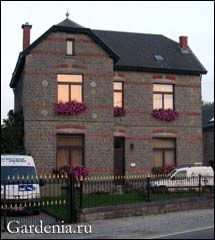
Falling shoots of ivy pelargonium with an abundance of openwork inflorescences form an attractive long-flowering cascade.
Due to its high decorativeness, this plant was chosen by me for planting in window boxes to decorate the sunny facade of our house. Against the background of stone walls, green flowering shoots of thyroid pelargoniums look very organic and impressive.
Pelargonium seedlings are planted in a narrow window box in a single row, at a distance of 15 cm from each other. With a significant width of the box (25 cm and wider), you can plant pelargonium seedlings in two rows, placing the plants in a checkerboard pattern.
Pelargoniums planted in a box should be gradually prepared for street conditions, to direct hot sun.
Boxes withhardened plants I put it outside after the end of spring frosts.
Caring for ivy pelargonium in window boxes during the warm season comes down to regular watering (when there is no rain) and top dressing. Small doses of complex mineral fertilizers and trace elements are applied weekly along with irrigation water.
Pelargoniums of several varieties look great together in a window box. No one can indifferently pass by this riot of colors without admiring the blooming pelargonium.
Having grown at least once a thyroid pelargonium, it is difficult to refuse this wonderful plant - you want to admire the bright cascade of its inflorescences every season.
Thanks to our mild climate, the ivy-leaved pelargonium reaches huge sizes during the long gardening season, forming countless flowers.
And when frosts approach, it's time to take care of preserving the beautiful pelargonium until the next garden season.
Wintering ivy pelargonium
It’s good if there is such a suitable place in your house where you can rearrange window boxes with pelargoniums for wintering.
Favorable conditions for wintering thyroid pelargoniums:
- light cool place;
- temperature of keeping plants in winter in the range of +5 ... +10 degrees;
- rare and careful watering of the soil (without wetting the stems and leaves).
Excessive watering of wintering pelargoniums leads to rotting of the roots and the appearance of diseases . And the surviving plants grow at the same time - they form very thin fragile shoots with small pale leaves.
As soon as the first autumn frosts are coming, I move the boxes with pelargoniums from the street to the bright, cool attic of our house.
In the off-season, it remains for me to periodically visit the attic for watering and processing wintering pelargoniums - removing yellowed and dried leaves. In this case, for pelargoniums, there is such a nuance: it is better to cut old leaves with scissors, leaving part of the leaf petiole on the shoot so as not to damage the “sleeping” axillary buds.
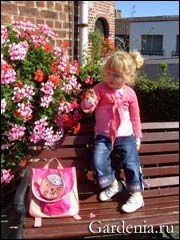
Last year, my sister Elena also grew wonderful ivy-leaved pelargoniums in the window boxes of her house. But autumn came, and the plants had to be attached for the winter. It was not possible to move the plants indoors directly in the boxes.
A lot of work was done: Pelargonium roots (along with an earthen ball) were removed from window boxes, packed in bags and transported to an empty cool room in our office. The root system of plants was laid close to each other in containers, and then the pelargonium rhizomes were covered with soil.
Ivy pelargoniums were supposed to winter in the office no worse than in the attic of my house.
But in the middle of winter, it suddenly turned out that these plants were attacked by ... mice. Out of nowhere, the rodents that appeared in the office not only ate all the shoots of pelargoniums, but also undermined the ground in containers and destroyed their roots.
Flower growers need to take this fact into account andprotect from rodents ivy pelargoniums.
If there is no suitable room for organizing the wintering of large specimens of pelargoniums in boxes, then at the end of summer it is necessary to cut cuttings from mother plants and root them in pots. In the same pots, young plants can winter in the house on the windowsill, near the glass itself. And in the spring, ivy-leaved pelargoniums are planted in window boxes.
Reproduction of thyroid pelargonium
Pelargonium breeds sowing seeds or cuttings.
You can get a large amount of planting material of different varieties through seed propagation. Breeders have bred a large number of hybrids of ivy pelargonium. On sale there are elegant seed mixtures that allow you to independently grow seedlings with a variety of flower colors.
Thyroid pelargonium seeds can be sown from the beginning of December (if additional illumination in winter) until the end of April. The depth of seeding into the soil is 5 mm. A bowl with a moderately moistened substrate is placed in a mini-greenhouse.
In a bright and warm place (+22 ... 24 degrees), high-quality pelargonium seeds germinate for about 1-1.5 weeks.
The main thing when growing pelargonium seedlings is careful watering, which does not allow flooding or drying out of the soil.
After 3 weeks, the grown pelargonium seedlings are picked.
When young plants begin to develop actively after picking, you can begin to regularly feed them with small doses of complex mineral fertilizer with microelements.
Cuttings are usually taken from the strongest, most ornamental plants in late summer.
You can also cut the cuttings in the spring from the uterine pelargonium, successfully preserved in the winter. Spring pruning of old lashes in queen cells promotes the growth of strong young shoots, on which many peduncles are laid.
Sliced cuttings of pelargonium are rooted in pots. Loose soil with a high sand content is suitable for rooting pelargoniums. The cuttings are planted along the edge of the pot, at a distance of about 2 cm from each other. Watering cuttings is limited, as the soil dries up.
For rooting cuttings of pelargoniums, the construction of a mini-greenhouse is not required, and even harmful: the preservation of moisture in the soil and the resulting condensate lead to plant decay. For the same reason, pelargonium cuttings are not recommended.root in water (the bottom of the cuttings often rots before the roots develop).
About 3 weeks after planting, the cuttings take root.
Pelargonium cuttings rooted in summer, successfully overwintered in coolness, by the beginning of the season turn into powerful plants, pleasing with abundant flowering.
Garden centers now sell many varieties of ivy-leaved geraniums with a variety of colors of inflorescences and with decorative leaves. Just a few seedlings of ampelous pelargoniums can create a colorful long-flowering cascade and provide a festive mood for the whole season.
When they say ampelous pelargonium, they mean ornamental plant, which looks great in hanging containers. The designation "ampel" is applicable to all plants that have this characteristic. The shoots are flexible, they are not able to grow straight up, but droop down or curl along the support. It is this property of the branches that makes it possible to make wonderful hanging gardens from this type of geranium. They are able to become a highlight in any placement: in a room, or a terrace, or in a garden. hallmark besides branching, there are also leaves.
Ampelous pelargonium has smooth leaves, and not like other species - with fluff. The length of the shoots is up to 90 centimeters, the flowers usually bloom at their very tips. However, unlike her upright girlfriend, she is rather capricious.
Location and lighting
He loves light very much and treats direct rays calmly, in this regard, it can be safely placed on well-lit windows. Don't forget to ventilate the room, while providing good protection against drafts. With the advent of the summer period, you can rearrange the pot on the balcony. With the arrival of the winter period, prepare a cool and fairly bright room.
Watering and humidity
Should be constantly maintained, keep an eye on this moment. Just don't overdo it. Remove all excess water from the pan in a timely manner. On hot summer days, geranium leaves should be sprayed twice a day. These preventive measures will help to avoid yellowing.
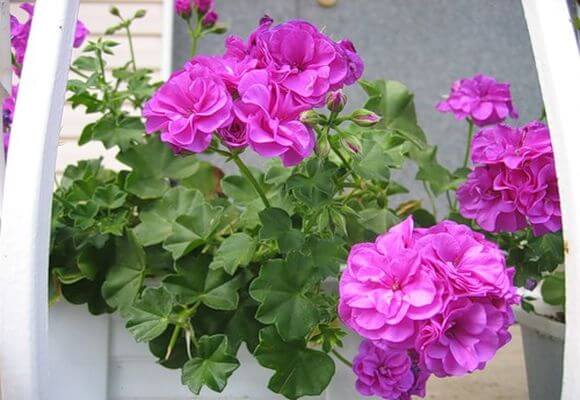
pruning
With the advent of the spring period, care must be taken. Such actions contribute to the good development of the plant. Cut shoots and cuttings are used to grow young specimens of the plant.
Priming
To do this, you need to take geranium seeds and sow them in the soil, which must be constantly moistened.
Temperature regime
The temperature limits should vary from 20 to 22 degrees above zero, and after the appearance of the first sprout, reduce to 15 degrees.
Experienced flower growers assure that growing ampelous pelargonium from seeds does not bring a positive result in every case.
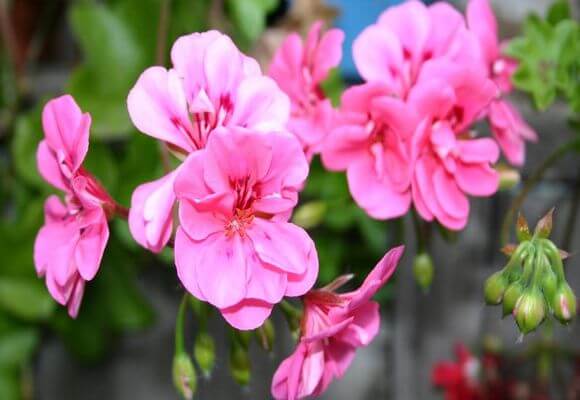
Capacity
Geranium has a negative attitude towards a spacious pot. You need to pay attention to the root system. Between its ends and the surface of the container should be no more than 2 centimeters. The flowering of pelargonium will be much brighter if this moment is taken into account.
reproduction
Reproduction of ampelous pelargonium cuttings
This process can be carried out with the presence of 10 centimeter shoots. should occur in early spring or at the end of summer. The remaining periods of the year may adversely affect the development of the flower. The cut cutting must be planted in the substrate of a separate container. It can be purchased at a specialized store or prepared by mixing peat and sand 1: 1. The soil must be disinfected before the rooting process. To do this, we process it with boiling water and keep it for about 15 minutes in the most heated oven.
After completing the entire list of processes, cool the soil to room temperature. The cuttings should only be dry, especially the places of cuts, each of which is necessarily processed with a growth stimulator. into the container after the completion of all manipulations.
A month later, roots will begin to appear, after which you can begin to dive the cuttings to a permanent place of residence. The procedure for pinching the plant after planting is mandatory. This will enable good development of the side cuttings. If you adhered to all the points and did not neglect the little things, then most likely, with the onset of summer, your ampelous pelargonium may begin to bloom.
Growing ampelous pelargonium from seeds
Among all types of domestic ampelous pelargoniums, only a few can be distinguished, which. The end of the spring period is considered perfect time to carry out this procedure.
Varieties of ampelous geranium
The very first hanging geranium that was available for purchase was Ville de Paris. It was obtained as a hybrid from thyroid geranium. There are ampelous varieties among the Angelic Pelargoniums. But the most common common feature of ampelous geraniums is shoots that resemble. Often ampelous pelargoniums are called that -. There are a lot of varieties of them. Here are some of the most popular and beautiful:
Ivy Geranium Amethyst
This variety has flowers of a bright purple color in diameter up to 2 centimeters. The peak of flowering is from mid-spring to late summer. The shape of the flowers is similar to roses.
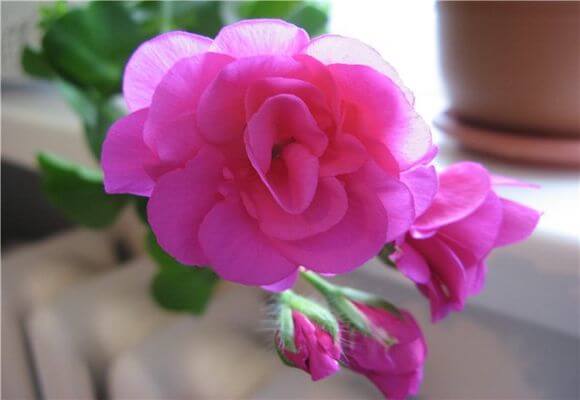
Pelargonium ivy Apricot
The flowers of this variety are apricot-pink. But for this ampelous pelargonium to have a beautiful and lush appearance it is necessary to pay enough attention to pinching the top of the head.
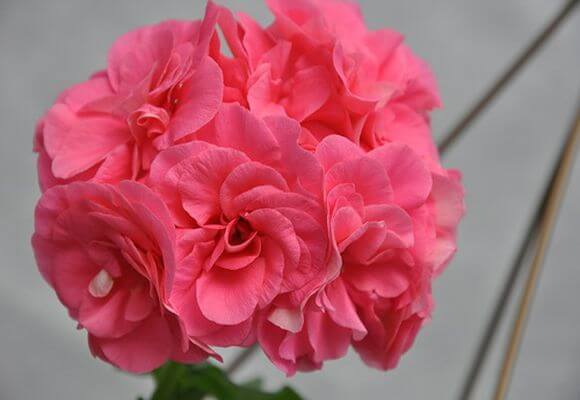
Ivy Geranium Mexico Nealit
This pelargonium has a very beautiful flowering color. Purple flowers make the white stripes very interesting. The back side of the petal has a light shade.
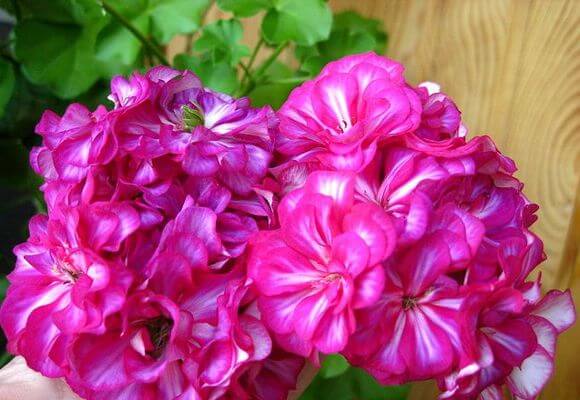
Pelargonium ivy Arctic Red
The flowers of this variety are bright red. There is also a pattern of dark lines on the petals.

Ivy Geranium Wiki
This variety is characterized by early flowering. It has beautiful large inflorescences, and the flowers themselves are pink terry.
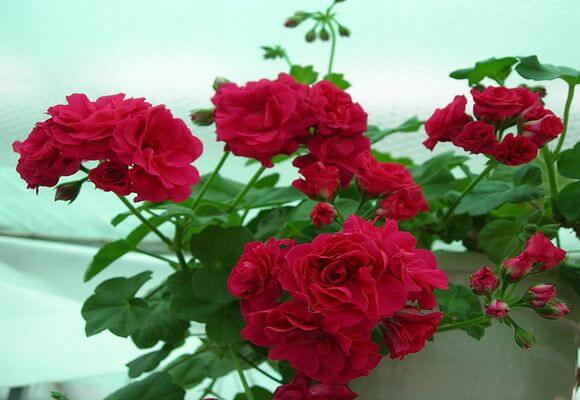
Pelargonium Ivy Mexico Tomato
This variety has pinkish-white, striped flowers.
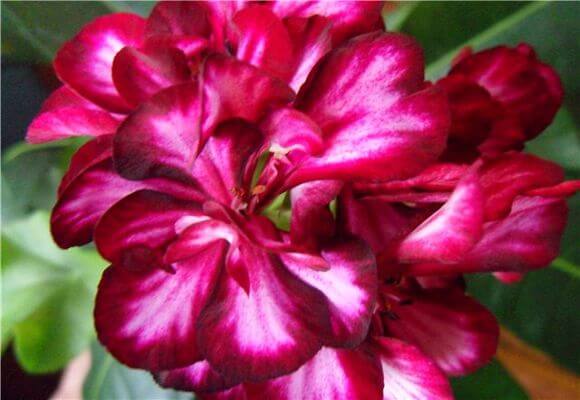
Ivy Geranium Pink Neon
This variety also has unusual flowers both in structure and color. His form, one might say, is “tousled”. Color can change. Hue changes from cold to warm. Or you can combine them both at the same time.
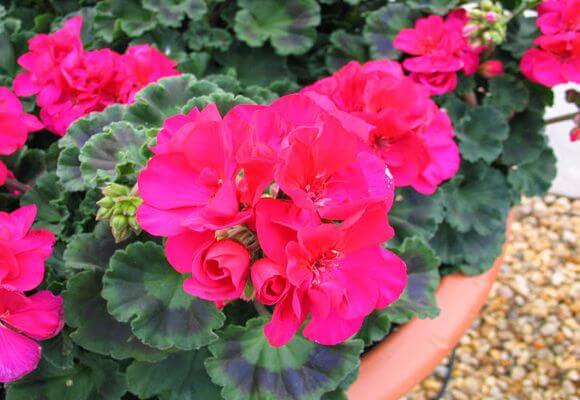
Pelargonium ivy Tommy
This pelargonium is the owner of semi-double large flowers, wine-blueberry color.

Geranium Ivy Rhapsody
The owner of very large semi-double flowers. Their color is dark beetroot.
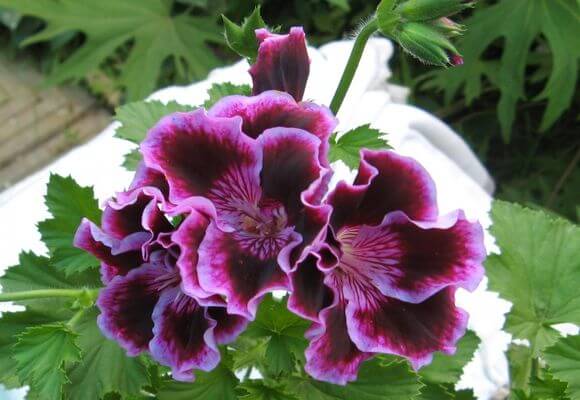
Pelargonium Ivy Tornado
This is a number of varieties that differ in flower color. They can be purple, pink, fuchsia. Their common business card- extraordinarily beautiful flowering. The flowers themselves are shaped like butterflies. And although this plant is miniature, in terms of flowering it can sometimes defeat especially large representatives of geraniums. With its flowering, this variety is able to please even in the winter months.
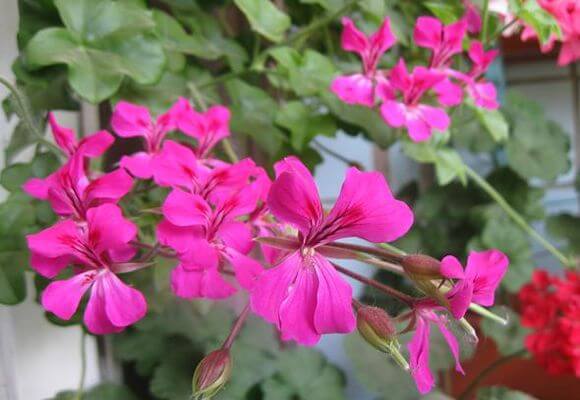
Geranium ivy Viva Carolina
This plant is another owner of extremely beautiful flowers. They are snow-white in her, and in shape they are an exact copy of the queen of flowers - roses. This geranium is also able to please its owner with vigorous growth.
![]()
Growing ampelous geranium, methods of its reproduction and important points care
It is often possible to observe that pelargoniums (geraniums) are considered as annual plants, leaving them to die in flower beds when the temperature drops below zero degrees Celsius. Although pelargoniums are not frost hardy, they can overwinter quite easily even if you don't have a heated greenhouse. Many gardeners like to keep their pelargoniums (geraniums) from year to year. This provides plants for the home during the winter and reduces the cost of buying new plants the following spring. With just a few simple steps, your geraniums can last for years.
Pelargoniums, most commonly referred to as geraniums, are wonderful plants that easily produce flowers one after the other all summer long. When the weather gets cooler, they usually bloom better, so it's no surprise that many gardeners want to bring them indoors and store them through the winter until next spring. Of all your outdoor geranium summer flowering plants, relocation can probably be done most successfully using one of the several methods available. Various geraniums grow well in our gardens, but some species are better for overwintering than others.
Perennial geraniums (genus Geranium) are simply left in the garden to overwinter with all other perennials. Another common name for perennial geraniums is Cranesbill. They are also called true geraniums. The rest of the geraniums that we most often grow in our gardens belong to the genus Pelargonium. This genus includes, in addition to the traditional zonal geraniums (geraniums), also ivy-leaved, fragrant and royal (known as Martha Washington pelargoniums). Zonal, scented, and ivy geraniums overwinter most successfully indoors.
But the royal (Martha Washington) geraniums need special attention, both during the growing season and during the winter. To bloom profusely, royal geraniums need cool temperatures. Keep them indoors in the winter in cool rooms (50-60 degrees Fahrenheit/10-15 degrees Celsius) that have a south or west window. Keep them at rest.
There are several methods for storing pelargoniums (geraniums) in winter.
Storing pelargoniums (geraniums) that will continue to grow indoors: before frost sets in, trim the geraniums to 1/2 to 1/3 of their original height, then carefully dig each plant out and place in 6-8 inch pots (15-20 cm). Check plants carefully to make sure they are free of insects or diseases.
Wintering indoors for plants is a difficult time; so take plants indoors that are in good condition. Water them well, then place the geranium pots on a bright, sunny windowsill or artificial light. Geraniums prefer cool indoor temperatures with daytime temperatures around 65°F (18°C) and nighttime temperatures around 55°F (13°C). They become tall and thin when grown in a warm, poorly lit area.
When indoors, water the plants only when the soil is dry, geraniums prefer to stay fairly dry unlike most other plants. Pinch back geraniums periodically to get stocky, well-branched plants.
The most reliable method of storing pelargoniums (geraniums) in winter is to take cuttings in August and discard old lignified plants. For best results, use tip cuttings 3-5 inches (7-12 cm) long. Remove any flower buds on the cutting, also remove the leaves from the bottom half of the cutting, dip the end of the geranium cutting in rooting hormone to help rooting faster. Place the cuttings approximately two inches deep in a clean pot filled with potting mix. Cuttings should be rooted in separate pots. After 3-4 weeks, the cuttings will develop strong roots.
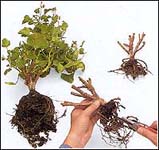
Rooted cuttings can be stored from mid-September on a windowsill in a well-lit and cool room. With enough light, geranium cuttings will develop into well-branched, vigorous plants by spring. Water sparingly until January, allowing the soil to dry between waterings. Start feeding in January as the plants begin to grow, use a liquid feed every 7-10 days. Pinch back in February to encourage branching. Transplant rooted cuttings to larger pots in April or earlier if space permits.
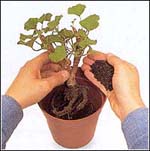
Older plants can be kept in boxes if they are dug up before the first frost and planted in John Innes No1 soil mix Peat, which is part of the soil mixture, improves air access to the roots, distributes moisture more evenly, reduces the need for frequent watering, facilitates the passage of water during irrigation when the soil is dry).
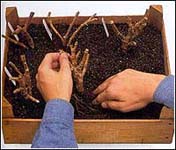
Prune plants in November to 10 cm (4 inches), remove all leaves. Keep the plants in boxes in a bright, cool but frost-free place, such as a cold greenhouse, a well-lit garage, or an unheated room. Very little water is needed for watering before the plants begin to grow in spring. Transplant the plants into pots in April.
There are less reliable methods of storing pelargoniums (geraniums) in winter, which can be used when there is no place to store plants brought from the garden. These are methods of storing geraniums with bare or exposed roots at rest in basements. Such methods are used for variants with stiff, lignified stems - this is the newsprint wrapping method or the plant hanging method.
Dig up the plants before frost sets in, carefully shake off excess soil from the roots, and let the foliage and stems dry. Remove as much soil from the roots as possible. Do this carefully because geraniums are quite brittle. Now you have two options in which form you will store geraniums in the winter - either you cut the stems to about half their length, or store the entire plant.
The success of these old methods depends on where you store your geraniums. The storage location should be dark, cool, moderately humid and protected from frost. A few years ago, fruit and vegetable cellars were quite common, and they served as an excellent place to store plants using these methods. These methods won't work in many basements today because the temperatures are too high and the humidity is too low. But because temperature and humidity vary from basement to basement, there's no way to know if the methods will work in your basement, so try these storage methods with a few plants. The ideal storage temperature for bare-rooted geraniums in the basement is 45-50°F (7-10°C).
Geraniums are hung upside down until spring on the basement rafters. If you don't have rafters, you can fold the geraniums individually into paper bags, one or two plants at a time, or wrap them in several layers of newsprint (the paper bag method is much neater than the hanging plant method). Leave bags open for ventilation.
Inspect your plants every month to see if they are getting too dry and shriveled. Spray hanging plants with water if necessary. If the geraniums become so dry that the stems begin to shrivel, remove them from the bags and soak the roots for an hour or two in cool water. After soaking in water, let them dry before placing them in paper bags. Do this several times during the winter to keep the plants from drying out.
Plants that have overwintered this way may take several weeks to start growing again in the spring. To get an early start of plants, in March, remove any dead branches from plants you have hung whole (healthy, live stems will be firm and firm) and prune all shoots to about 10 cm (4 inches) from the main stem before planting them in pots. . Those plants that you previously cut back should already be showing signs of growth. Before planting in pots, soak the geranium roots for several hours in water in which half the fertilizer is dissolved. You can pot plants indoors a few weeks before the last frost so you can transplant them into flower beds later.
No matter how you store your pelargoniums (geraniums) over the winter, don't put them outside until you're sure the danger of frost has passed. By using any of these storage methods, you will have good looking geraniums in spring and summer despite not being hardy!
Beginning flower growers are often treated with caution when growing pelargoniums. For some, these plants are associated with capricious royal plants that require increased attention, while others are associated with the elongated shoots of the “grandmother's ball”, which poorly pleases with lonely panicles of flowers with a sugary-dense smell. Fortunately, acquaintance with Pelargonium ivy can radically change this attitude towards these long-familiar, but still very relevant houseplants. The ampelous growth of pelargonium ivy, combined with endurance and unpretentiousness, makes it the most “universal” in terms of use against the background of other species, because in terms of abundance, and even more so in terms of the duration of flowering, it can “push behind the belt” even many “royal” varieties.
In literary sources, this plant is found under the names of ivy-leaved pelargonium, or thyroid pelargonium (Pelargonium peltatum), and among the people appears as cascading geranium - Eng., Hanging or just ampelous pelargonium. Judging by the names, the free growth of long hanging shoots and ivy-like leaves (“Ivy” translated from English as “ivy”) could be considered the main signs of pelargonium ivy, but not all of its varieties have such characteristics. Since the appearance on the market of the first grade ("Ville de Paris", 1786), obtained by crossing the p. thyroid (P. peltatum) with the p. faceted (P. laterites), until early XIX centuries, only newly obtained varieties were involved in the process of hybridization. But the "introduction" into the crossing of specimens of zonal and royal pelargoniums and the appearance of the first terry variety "Madame Crousse" brought this plant to a new round of popularity. Today, the group of ivy-leaved pelargoniums includes evergreen ampelous miniature (stem length no more than 25 cm), compact and vigorous (up to 150 cm) plants with thin, drooping or creeping shoots and dense shiny leaves. In most varieties, the leaves have a pronounced ivy shape and a solid green color (“Ville de Paris”, “Amelit”, “Jacky Gauld”, “Amethyst”), but in some they are very similar to the leaves of zonal ancestors, not only in shape, but also color - with a concentric pattern of brown or bronze shades ("Ivy Scarlet", "Ivy Arctic Red", "Mauve Beauty", etc.). An absolutely stunning effect is produced by variegated varieties with leaves decorated with white-golden venation ("Crocodile", "Crock-o-Day", "Cotta Rio Grande", "Crocketta"), chaotic spots ("Wood "s Surprise", "Variegated Giroflee") or edging ("Dancing Queen", "Evka", "Variegated Bonito"). If we add to all of the above that some varieties of ivy pelargoniums also have a pleasant aroma, then it can be argued that these plants can be a godsend for lovers of both zonal and variegated, and fragrant pelargoniums.
note: not all trailing pelargoniums (having ampelous growth) belong to ivy. So, in particular, ampelous varieties with long, not rigid, cascading stems are also among the Angelic Pelargoniums - "Wychwood", "Rose Bengal", "Veronica Contreras", "Rollers Shadow" and "Darmsden". Despite the fact that in the spring-autumn period, in unpretentiousness, these plants are not much inferior to ivy-leaved relatives, they make increased demands for wintering, like “royal” specimens. By the way, some flower growers tend to believe that outwardly Angelic pelargoniums are significantly inferior to ivy-leaved ones due to smaller leaves and flowers similar to pansies, but this, as they say, is already a matter of taste.
Characteristics of pelargonium ivy
A common feature for all ivy pelargoniums can be considered long (on average 12 - 18 cm) peduncles, bearing 5 - 8 flowers in umbellate inflorescences. Flowers can be simple, butterfly-like ("Cascade Pink", "Tornado Lilac", "Tornado Rose"), semi-double ("Blanche Roche", "Tomcat"), double, reminiscent of azalea or peony flowers ("Mrs. Martin" , "Amelit", "Amethyst"), and even pronounced rose-like ("Chiffon", "Ice Rose", "Jackie", "Lilac Rose", "Sybil Holmes", etc.). The color includes the richest gamut from delicate white, pink and lilac to rich red, purple and burgundy shades in both monophonic and two-tone variations in the form of either contrasting strokes / edging on the petals ("Crock-o-Day", "Rouletta", "Crocketta", "Harlequin Miss Liver Bird", "Harlequin Rosy O "Day"), or color highlighting of the stamens against the general background of the flower ("Blanche Roche"). South Africa- in its historical homeland - ivy-leaved pelargonium usually blooms in autumn (September - November), and in our climate - from May to the end of August. Due to pinching / pruning, the flowering time may shift, but, as practice shows, with sufficient lighting, this plant blooms willingly even in winter. Of course, a single flower or inflorescence of ivy-leaved pelargonium in size can greatly lose to royal specimens, but if we compare the bushes during flowering in general, the ivy-leaved one wins in the number of flowers due to the volume of green mass and inflorescences forming a flowering cloud.

Interestingly, many flower growers appreciate the ivy-leaved pelargonium because it grows many shoots and blooms profusely in a small pot, without requiring regular transplanting into a large container, like most indoor plants. This makes her one of best plants for hanging baskets and planters. And its high resistance to temperature extremes, heat and drought allows it to be planted also in balcony containers and outdoor window boxes for decorating house facades, shop windows, verandas and balustrades. In this case, the greatest decorative effect, as a rule, is achieved by planting several contrasting varieties in a common container - during flowering, they create an unforgettable look of a “motley waterfall”. In the conditions of a modest window sill, a similar effect can be created by growing vigorous, actively branching varieties (Antik Peach, Amethyst, Cascade Pink, Drezden Apricot) on a trellis. To do this, in the spring, with the beginning of active growth, you need to pinch the plant short enough on one side (to insert the grate into the pot as close to the center as possible) and put it in a permanent, well-lit place with the grate against the wall. As the shoots grow, they should be carefully fixed on the trellis with plastic garters, while constantly holding forming pinches. As a rule, ivy-leaved pelargoniums grown in this way easily outgrow a trellis 1 m high until autumn, but due to regular pinching, they usually bloom later than their "balcony sisters".
By the way, the options for using pelargonium ivy are not limited to this. As practice has shown, in the conditions of a southern climate, it can serve as an original ground cover plant for a garden: like zonal pelargoniums, ivy can be planted in open ground with the onset of stable heat. However, it should be borne in mind that a lot of space is required for its growth - it does not tolerate close proximity to other plants at all (shading, thickening). And it is advisable to land in the ground without removing the pelargonium from the pot, otherwise it will actively branch and grow to the detriment of flowering. Despite the fact that this plant tolerates a decrease in temperature to +5 ° C without problems, even minimal frosts are already fatal for it, therefore, for the winter, the ivy-leaved pelargonium will still have to be dug out of the ground and transferred to the room.
Growing pelargonium and ivy
It is very unusual and very original to grow this pelargonium on a bole, but this method is more suitable for already experienced flower growers who own the “art of grafting”. The closest relatives of the ivy - zonal pelargonium - are considered an excellent stock for her, so powerful tall varieties are ideal as a bole. The grafting procedure is recommended to be carried out in early spring (March), and it is better to choose plants of approximately the same age for rootstock and scion, otherwise characteristics older plants will later become dominant. It is interesting that this method allows you to plant cuttings of several varieties on one rootstock and as a result get a lush “tree” that blooms in two shades - why not standard roses in miniature? The easiest way to graft is to make 1 - 1.5 cm identical oblique cuts on the stem of the rootstock and the stalk of the scion, combine them and fix them tightly with plastic tape or thick woolen thread so that they do not move. It is advisable to carry out the procedure as quickly as possible and use a disinfected instrument. A week after this, the plant should be kept in a dark place in a greenhouse (or with a plastic bag tied to the top of the stem). Then organize regular ventilation and after 3 days transfer the pelargonium to normal room conditions, but not under direct sunlight, since the fusion will be completed on average only after 3 weeks.
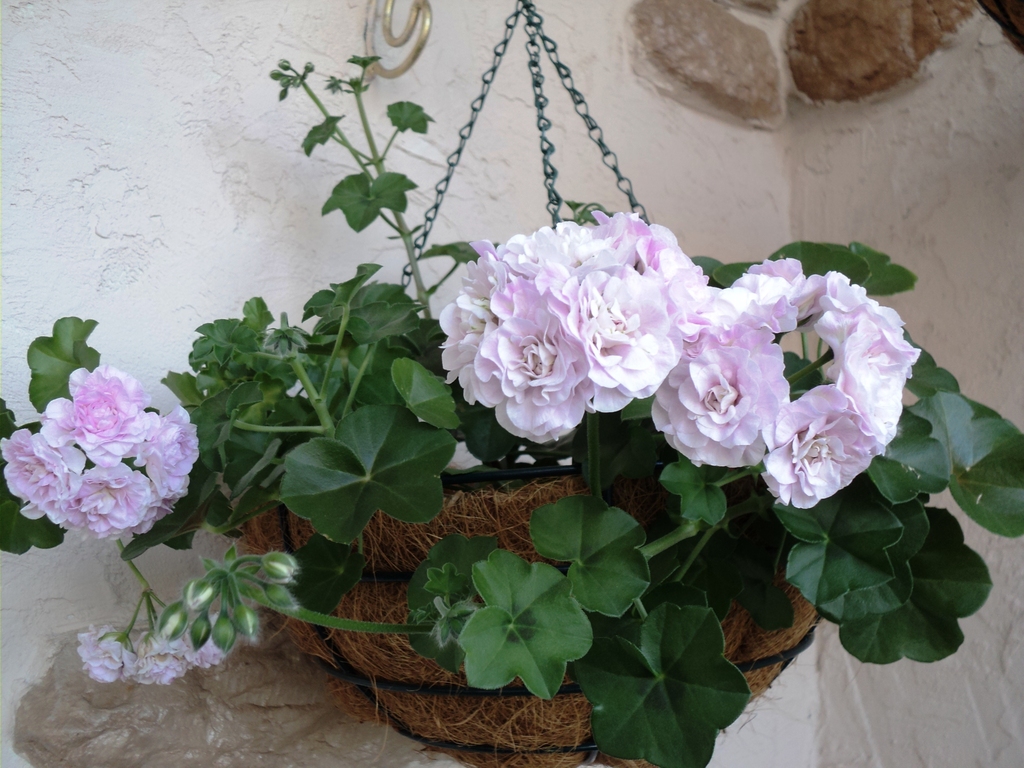
It is possible to grow ivy-leaved pelargonium, as well as zonal, either from seeds or from cuttings that readily take root in the ground. When growing from seeds, buying them is perhaps the biggest problem, as they do not often come to flower shops. It is possible to sow them in bowls with a wet mixture of peat, soddy soil and sand (1: 1: 1) in the presence of additional lighting in late autumn - winter. Seeding depth - maximum 5 mm, germination time in a greenhouse with high humidity, temperature 22 - 24 ° C and periodic ventilation - 1 - 3 weeks (depending on the quality of the seeds). 2-3 weeks after germination, seedlings can be dived into separate 5-cm pots, with the onset of active growth, begin to feed them with complex mineral fertilizers in very small doses and, as necessary, transfer them to large containers. When planting several pelargoniums in a common pot, it should be borne in mind that one adult plant should have an average of no more than 1 liter of soil mixture volume, and it is advisable to plant them in a common balcony container at a distance of at least 15 cm from each other, either in a checkerboard pattern or along the edge pot. Since the ivy plants grown from pelargonium seeds bloom on average after a year and need mandatory winter lighting, it is much more profitable for flower growers to propagate these plants by cuttings. As practice confirms, this method of reproduction is often also the only option for preserving pelargoniums in the winter.
note: if the plants will later be used as balcony or garden plants, they must be hardened before planting - gradually accustom to sunlight. With any method of cultivation, it should be borne in mind that ivy-leaved pelargoniums (including seedlings and young plants) tolerate drought and heat better than dampness and waterlogging of the substrate, which provoke the appearance of diseases and pests. Particularly dangerous for specimens growing in open field and on the balcony, they represent the so-called “rainy seasons”: due to the constant dampness of the substrate, thickenings and “scars” are formed on the back of the pelargonium leaves, merging into large spots. This edema is a disease that is treated by an elementary regulation of the watering-drying regime, but, unfortunately, it is not always possible to provide its “street” specimens. To prevent this disease, all ivy-leaved pelargoniums are recommended to be watered only after the earthen coma has completely dried. Note: in the summer, on a south-facing balcony, they will not only have to be watered daily, but also periodically (not constantly!) Sprayed in the evening.
Ivy Pelargonium Care
The ivy-leaved pelargoniums are not only tolerant of bright lighting, but they constantly need it, since the lack of light causes them to stop growing and fall off the leaves until the shoots are completely exposed, not to mention the absence of flowering. This is especially pronounced on “street” specimens transferred indoors and during their wintering at home: without additional lighting, many plants take on a miserable appearance by spring, and some even die.
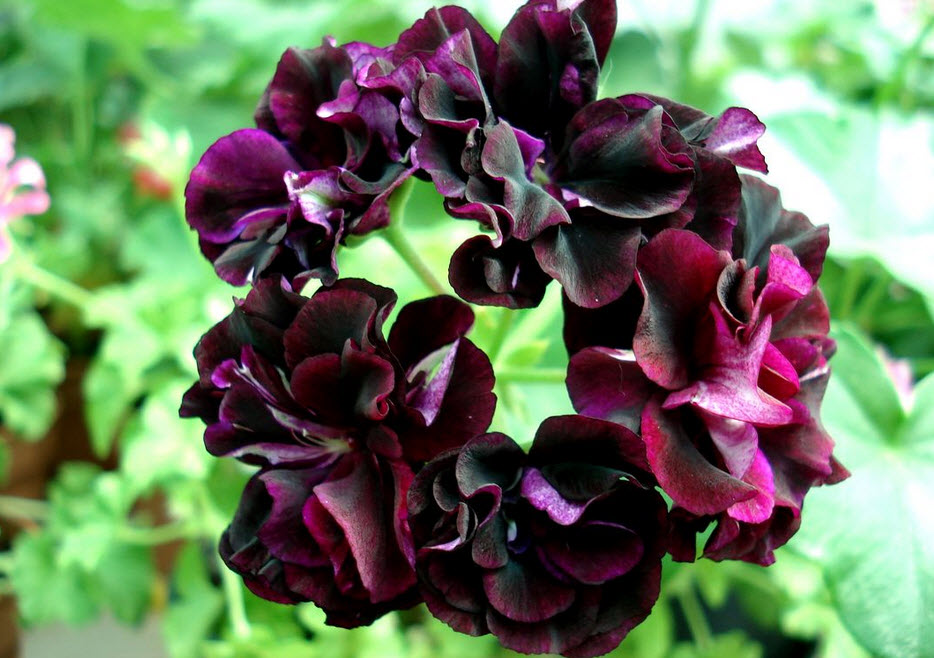
If the suspension of the growth of ivy-leaved pelargonium is observed with sufficient lighting, the reason should be sought in the inappropriate acidity of the substrate. It is recommended to keep it between 6.0 - 6.5 pH, which is easily achieved by adding soil mixture annually and transplanting every 2 years. Otherwise, the absorption of nutrients by the roots is disturbed, even if they are regularly received in the form of top dressing. By the way, healthy ivy-leaved pelargoniums should be fed every 7 to 10 days with fertilizers for balcony plants or special fertilizers for pelargoniums (Biomaster, Kemira-Lux, Pelargovit, etc.). An infusion of onion peel can also serve as a good top dressing and prevention from pests. To prepare it, you need to pour 4 handfuls of onion peel with a bucket of boiling water, leave for 2 days, and then dissolve 1.5 liters of this infusion in a bucket of clean water and use it for periodic watering / fertilizing or spraying plants.
The most difficult in the content of ivy pelargoniums, perhaps, can be considered the winter period. On the one hand, when creating additional lighting, it is very problematic to place a group of vigorous specimens with meter-long shoots in a room - after all, under such conditions, they will continue to grow even in winter. On the other hand, in order to stop stretching in low light, it is desirable to reduce the temperature of the content to 10 - 15 ° C, which is also difficult to do in a living room. Ideally, it is better to cut “street and balcony” plants in the fall (before the onset of frost), leaving “stumps” of 10–12 cm each, dig them out, place them in a common container or plastic bag, sprinkle the roots with moist soil, and transfer to a cool (5–10 ° C), but a bright room (attic, glazed loggia, in extreme cases - a basement). If possible, containers (pots) can be moved with plants without digging them up. At the same time, it is very important to take care of protection against rodents, because mice can completely destroy valuable planting material. The cuttings obtained as a result of pruning should be rooted and provided with relatively cool maintenance (16 - 18 ° C) and artificial lighting until the end of winter.
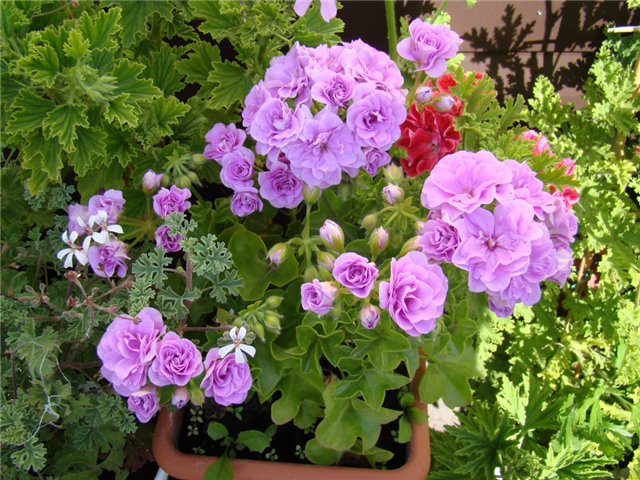
In the spring, with the beginning of the growing season, the overwintered mother plants will need to be planted in a fresh soil substrate and gradually accustomed to new conditions. This technique allows you to provide a compact wintering for several plants at once, and in case of their death, preserve the varieties in the form of rooted cuttings. If there are no other options besides wintering in the apartment, it is recommended to place ivy-leaved pelargoniums suspended in flower pots (away from radiators) on the brightest window. At the same time, it is advisable to transfer the strong pruning of plants to spring, and in the fall to shorten the shoots only partially (root the cuttings too) in order to prevent the occurrence of diseases due to poor ventilation and depletion of the plant. If by the spring the pelargoniums still stretch out a lot, you will have to carry out another pruning to give them the desired shape and stimulate branching. Remember: Ivy pelargoniums should be watered very sparingly during wintering, because dampness and coolness create ideal conditions for the development of fungal diseases.
As you can see, the ivy-leaved pelargonium has much less disadvantages than its advantages, and its cultivation will not be a problem even for beginner flower growers. And since there are several options for “application” and winter storage of this plant, it’s a sin not to try to use at least one of them in order to acquire, to the envy of all neighbors, a chic “blooming waterfall” on a trunk, trellis or just in a balcony container ..